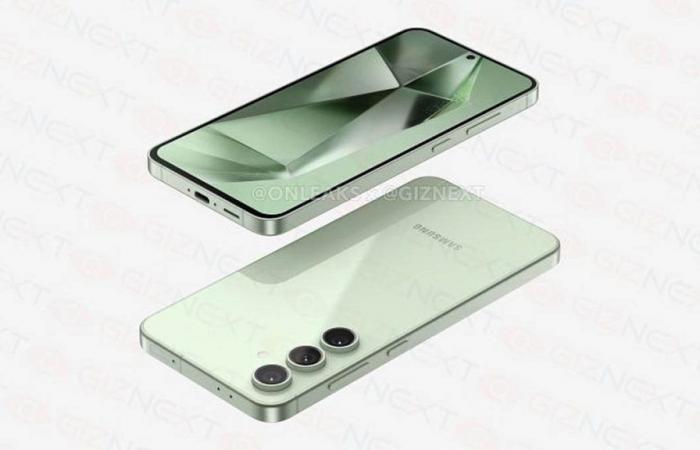
The designs of the three selected models are distinguished by marked aesthetic choices and specific finishes. The Xiaomi 14T displays an organization of its photo sensors on the back in the form of a square integrated into a plate of the same color as the rest of the back, located in the upper left corner. This layout incorporates three sensors placed in a square with slightly rounded edges and flat profiles.
Available in black, graphite, lime green or blue, the Xiaomi 14T has a glass back which gives it a premium look. For its part, the Samsung Galaxy S24 FE 5G opts for a sleek and minimalist design with photo sensors arranged individually, without a prominent outline. The absence of a distinct block gives a more homogeneous appearance. The sensors simply sit on the aluminum back, giving a sleek, modern appearance. Available colors include graphite, blue, yellow and green.
The Galaxy S24 FE 5G is designed with flat profiles and rounded corners, respecting the aesthetics of the Galaxy series models. As for the iPhone 16, it retains the DNA of the range with a square of sensors at the top left of the back, similar to previous generations. It offers a new button that allows you to control certain camera features, as well as an Action button inherited from previous generations. Its profiles are also flat with rounded corners. The smartphone is offered in five colors: black, white, pink, green and blue, with an aluminum frame that ensures lightness and robustness.
In terms of dimensions, the iPhone 16 is the most compact of the three and the lightest of the selection. The Xiaomi 14T is positioned between the other two in terms of size and weight while the Samsung Galaxy S24 FE 5G, on the other hand, is the largest and heaviest.
Regarding autonomy, the Xiaomi 14T offers a 5000 mAh battery, the largest in this selection, promising substantial autonomy, in particular with optimized management of the MediaTek Dimensity 8300-Ultra processor. Its fast charging at 67 watts is the most powerful, although the model does not support wireless charging.
The Samsung Galaxy S24 FE 5G, with its 4700 mAh, is just below. It supports wired charging at 25 watts and boasts wireless charging capability at 10 watts, as well as reverse charging to power other devices. The iPhone 16, for its part, has a more modest 3274 mAh battery, but compensates with efficient energy management of the Apple A18 chip. It supports wired charging at 30 watts and stands out with its wireless charging capability of up to 25 watts, as well as reverse charging at 7.5 watts.
Which is the most powerful and what configurations for photos?
In terms of performance, the three smartphones are equipped with high-end processors suitable for intensive use. The Xiaomi 14T has a MediaTek Dimensity 8300-Ultra associated with 12 GB of RAM and 256 GB of storage, but it does not offer micro SD card expansion.
The Samsung Galaxy S24 FE 5G features a Samsung Exynos 2400e with 8 GB of RAM and options of 128 GB or 256 GB of storage, without the possibility of expansion. Finally, the iPhone 16 uses the new Apple A18 chip, coupled with 8 GB of RAM and offers options of 128 GB, 256 GB or 512 GB of internal storage, but without a micro SD slot. In terms of raw power, the Apple A18 in the iPhone 16 is undoubtedly the most efficient processor, followed by the Dimensity 8300-Ultra in the Xiaomi 14T, while the Exynos 2400e in the Galaxy S24 FE is slightly behind.
All of these smartphones offer impressive photo configurations, but with nuances in the use of sensors. The Xiaomi 14T offers a 50-megapixel main sensor, a 12-megapixel ultra-wide-angle and a 50-megapixel telephoto lens with 2.6x optical zoom.
The Galaxy S24 FE 5G is equipped with a 50-megapixel main sensor, a 12-megapixel ultra-wide-angle and an 8-megapixel telephoto lens with 3x zoom. As for the iPhone 16, it has a 48-megapixel main sensor and a 12-megapixel telephoto lens with 2x optical zoom.
For selfies, the Xiaomi 14T stands out with a 32 megapixel sensor, while the Galaxy S24 FE and iPhone 16 make do with 12 megapixels.
What is the best screen and what connectivity?
All models are equipped with AMOLED panels, but with distinct characteristics. The Xiaomi 14T offers a 6.67-inch screen with a definition of 1220×2712 pixels, a peak brightness of up to 4000 cd/m² under certain conditions and a refresh rate of 120 Hz. The Samsung Galaxy S24 FE 5G has a 6.7-inch screen, with a definition of 1080×2340 pixels and a peak brightness of 1900 cd/m². Its refresh rate is also 120 Hz.
The iPhone 16 offers the smallest screen with 6.1 inches, a definition of 1179×2556 pixels, a peak brightness of 2000 cd/m² and a refresh rate of 120 Hz.
The smartphones that we compare here offer varied connectivity technologies adapted to current uses. The Xiaomi 14T supports Wi-Fi 6E, a high-performance and fast standard, and benefits from Bluetooth 5.4 technology for improved connectivity and reduced power consumption. It also has NFC for contactless payment and other data exchanges. However, it does not offer a jack socket.
The Xiaomi 14T has an infrared transmitter, a rare but handy feature for controlling devices like TVs. In terms of security, its fingerprint reader is placed under the screen, offering discreet and intuitive access. The smartphone is IP68 certified, ensuring complete dustproofing and water resistance up to 1.5 meters deep for 30 minutes.
The Samsung Galaxy S24 FE 5G is also compatible with Wi-Fi 6E and Bluetooth 5.3. Like the Xiaomi, it is equipped with NFC for mobile payments, but it has neither a jack nor an infrared transmitter. It is IP68 certified, which makes it as resistant as the Xiaomi to water and dust. Its fingerprint reader is also placed under the screen. The iPhone 16 also supports Wi-Fi 6E and uses Bluetooth 5.3, while integrating NFC for transactions via Apple Pay.
Like the other two models, it does not offer an audio jack or an infrared transmitter. However, it stands out for the lack of a fingerprint reader, which could put off some users. In terms of resistance, it is also IP68 certified, placing it at the same level of protection as the Xiaomi and the Samsung.





